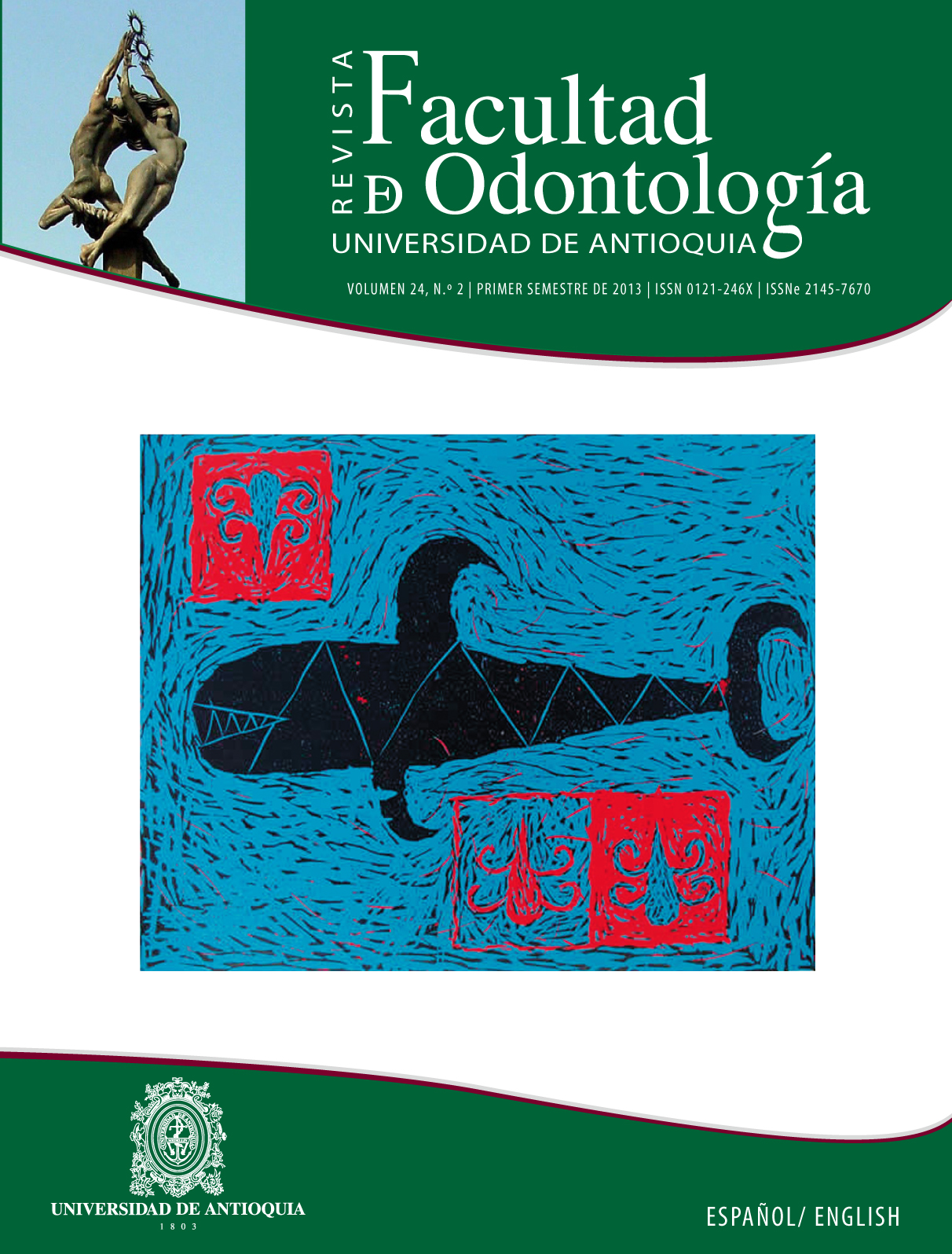Adhesión posaclaramiento e intervalos de tiempo: revisión de tema
DOI:
https://doi.org/10.17533/udea.rfo.10332Palabras clave:
Blanqueamiento dental, Adhesión, Agente antioxidanteResumen
A pesar del tan alto éxito clínico de los procedimientos de aclaramiento dental, no todas las dudas sobre su uso han sido explicadas, mucho menos los efectos adversos sobre la resistencia de unión de restauraciones adhesivas en esmalte/dentina, los cuales todavía siguen siendo muy controvertidos. Esta revisión de tema tiene como objetivo analizar conceptos sobre la interacción entre adhesión posaclaramiento y tratamientos para controlar esas interacciones. Con base en la literatura revisada se puede concluir que un tiempo de espera entre aclaramiento y procedimiento restaurativo debe ser por lo menos de 7 días para que todo el oxígeno residual remanente pueda ser liberado de la estructura dental y, en los casos que sea necesario hacer una restauración inmediata al proceso de aclaramiento, el uso de agente antioxidante como ascorbato de sodio 10% en la forma de gel es una alternativa viable para disminuir los efectos del aclaramiento en el procedimiento adhesivo.
Descargas
Descargas
Publicado
Cómo citar
Número
Sección
Categorías
Licencia
Derechos de autor 2013 Revista Facultad de Odontología Universidad de Antioquia

Esta obra está bajo una licencia internacional Creative Commons Atribución-NoComercial-CompartirIgual 4.0.
El Derecho de autor comprende los derechos morales y los derechos patrimoniales.
1. Los derechos morales: nacen en el momento de la creación de la obra, sin necesidad de registro. Corresponden al autor de manera personal e irrenunciable; además, son imprescriptibles, inembargables y no negociables. Son derechos morales el derecho a la paternidad de la obra, el derecho a la integridad de la obra, el derecho a conservar la obra inédita o publicarla bajo seudónimo o anónimamente, el derecho a modificar la obra, el derecho al arrepentimiento, y el derecho a la mención, según definiciones consignadas en el artículo 40 del Estatuto de propiedad intelectual de la Universidad de Antioquia (RESOLUCIÓN RECTORAL 21231 de 2005).
2. Los derechos patrimoniales: consisten en la facultad de disponer y aprovecharse económicamente de la obra por cualquier medio. Además, las facultades patrimoniales son renunciables, embargables, prescriptibles, temporales y transmisibles, y se causan con la publicación, o con la divulgación de la obra. Para el efecto de la publicación de artículos de la Revista de la Facultad de Odontología se entiende que la Universidad de Antioquia es portadora de los derechos patrimoniales del contenido de la publicación.
Yo, el(los) autor(es), y por mi(nuestro) intermedio, la Entidad para la que estoy(estamos) trabajando, transfiero(imos) de manera definitiva, total y sin limitación alguna a la Revista Facultad de Odontología Universidad de Antioquia, los derechos patrimoniales que le corresponden sobre el artículo presentado para ser publicado tanto física como digitalmente. Declaro(amos) además que este artículo ni parte de él ha sido publicado en otra revista.
Política de Acceso Abierto
Esta revista provee acceso libre inmediato a su contenido, bajo el principio de que poner la investigación a disposición del público de manera gratuita contribuye a un mayor intercambio de conocimiento global.
Licencia Creative Commons
La Revista facilita sus contenidos a terceros sin mediar para ello ningún tipo de contraprestación económica o embargo sobre los artículos. Para ello adopta el modelo de contrato de licenciamiento de la organización Creative Commons denominada Atribución – No comercial – Compartir igual (BY-NC-SA). Esta licencia les permite a otras partes distribuir, remezclar, retocar y crear a partir de la obra de modo no comercial, siempre y cuando nos den crédito y licencien sus nuevas creaciones bajo las mismas condiciones.
Esta obra está bajo una Licencia Creative Commons Atribución-NoComercial-CompartirIgual 4.0 Internacional.














